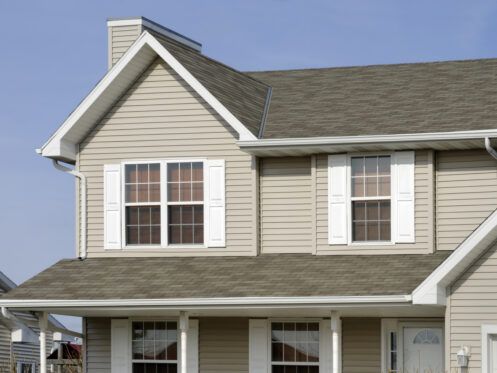Replacing your siding is a significant investment. Keeping it in optimal condition is, therefore, crucial to avoiding this big expense. While a durable siding solution is always an effective way to improve your curb appeal and protect your home, it still requires regular attention to stay in functional condition. High-quality siding can also add value to your property. With these benefits in mind, here are seven essential maintenance tips for making your siding last as long as possible.
1. Clean Your Siding Annually
How often you should clean your siding depends on your siding material. Some siding solutions are more durable and require less maintenance than others. The best approach is to consult the manufacturer’s recommendations for the specific cleaning intervals.
As a rule of thumb, you should wash vinyl, metal, or composite siding at least once a year. Fiber cement siding may require cleaning every six months, however. We generally recommend this same cleaning frequency for wood, as well. The routine cleanings will help keep your siding free of mold, mildew, and excess grime.
2. Regularly Check for Damage
Checking for siding damage often, especially after a heavy storm, is the best approach to prevent costly repairs and extend the life of your home’s exterior. Some common signs of damage include cracks, holes, warping, and loose or missing panels. Most siding damage is storm- and weather-related. However, defects can emerge after improper installation, heavy wear and tear, and pest infestations.
Many homeowners can usually identify glaring siding defects, but a proper assessment requires professional assistance. If you notice multiple points of damage, we encourage you to contact our team at Warren Thompson & Son Roofing & Siding for an expert evaluation. In scenarios where you can’t determine the cause of damage or have safety concerns about inspecting further, working with a team of siding experts is the best way to go.
3. Choose the Appropriate Cleaning Agents
We mentioned using soapy water and laundry detergent to clean your siding. However, there are other cleaning solutions you can make on your own. The cleaning agent you should use depends on the type of cleaning you need. A vinegar solution is one safe option for clearing mold and mildew from your siding. For stained vinyl, consider using household cleaners like Windex, Murphy’s Oil Soap, or Lysol. These products work great for removing dirt, grease, rust, and other difficult-to-remove stains.
Steer clear of harsh cleaners like paint thinner, nail polish remover, and spot remover, particularly on vinyl siding. Undiluted bleach furniture cleaners can also damage vinyl siding products. Using these cleaning agents will cause your siding to change color and eventually fade. For wood siding, mix 70% water to 30% white vinegar in a garden sprayer and apply it directly to your boards. Finally, remove the dirt and debris with a bristle brush before rinsing the siding down with your garden hose.
4. Avoid High-Pressure Washing
Pressure washers are effective for cleaning your siding and are relatively inexpensive to buy or rent. They offer an efficient solution for cleaning your exterior without using a brush and soapy water bucket. The safest way to use a pressure washer on your siding is to avoid running it at its highest settings. Pressuring washing at the highest modes can damage the surface of your siding and send water behind it. This can introduce moisture and mold issues to your home.
The trick is to start on a low-pressure setting and adjust the pressure upward to a safe and non-destructive level. Gas-powered pressure washers are more effective at cleaning two-story dwellings because they’re more powerful. They can reach those higher, out-of-reach surface areas. Avoid power washing wood, however, as this method can loosen caulk, chip paint, and damage your boards. In general, you should always wash your siding at a low pressure or hire an expert in Alpha to handle this task for you.
5. Promptly Repair Minor Siding Defects
Minor holes and cracks in your siding can quickly devolve into a more expensive problem if you don’t address them swiftly. These defects open the door for water to infiltrate behind your siding and develop the conditions for mold growth and wood rot that can cause structural damage. One of our siding experts can repair minor siding flaws with a professional siding repair kit.
We’ll bring all the necessary materials and prep the area. Using a knife, we’ll snip and cut away any loose vinyl materials around the holes. This process also requires caulking and potentially touching up the vinyl with paint. Even for minor repairs like these, we recommend you partner with a professional siding expert for these instead of completing the work yourself. A trustworthy service provider can also identify more hidden damage you might not have detected.
6. Fix Your Drains and Gutters
Proper drainage is vital for protecting your siding from rainwater damage. If you have defective gutters that aren’t channeling water away from your home, we recommend you address them promptly. Clogged, damaged, or improperly installed gutters cause water to pool around the base of your walls. This creates a breeding ground for mold and algae growth. It also contributes to potential foundation issues.
Routinely maintain and clean your gutters to remove leaves, debris, and other blockages. Look for leaking sections of your cutters or any areas that appear to be pulling away from your roof. The excessive moisture caused by defects like these can prompt your siding to warp, crack, and buckle. For homes with wood siding, a poor gutter system can cause rot and mold issues in both your siding and fascia boards. Hiring a professional to repair your gutters is the most proven approach for ensuring adequate exterior waterproofing.
7. Trim Back Nearby Trees and Shrubs
Your landscaping can add value to your home, but if you don’t maintain it, your trees and shrubs can damage your siding. Branches and leaves that constantly rub against the surface of your home’s exterior will scratch and can even puncture vinyl or wood, eventually weakening it over time. Dense vegetation can also trap moisture against your home, creating the conditions for mold, mildew, and rot.
To combat this, regularly trim any trees, plants, or shrubs in close proximity to your siding. Ensure enough space between your home and landscaping to allow proper airflow that keeps the area dry and reduces potential siding damage. Removing dead leaves and debris from your landscaped areas also prevents blowback that can stick to your siding and cause staining.
Need Help With Your Siding Maintenance?
Following these seven tips will help extend the life of your siding and preserve its overall appearance. These proactive measures also help protect your home from potentially costly structural damage. If you need assistance with siding maintenance and upkeep, our team at Warren Thompson & Son Roofing & Siding in Alpha, NJ is just a phone call away. In addition to siding, we also offer residential and commerical roofing services, gutter cleaning, and a full range of roof repairs.
For more on how we can help keep your siding in great-looking condition and extend its lifespan, contact us at Warren Thompson & Son Roofing & Siding now!

